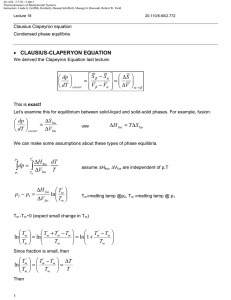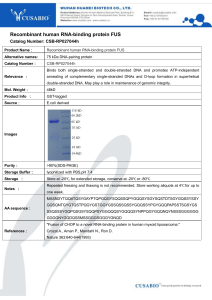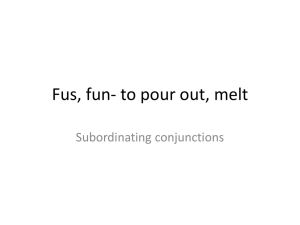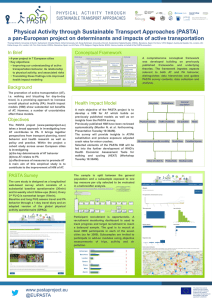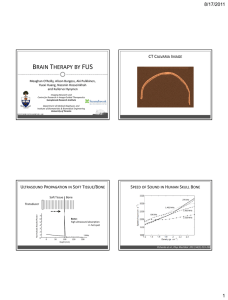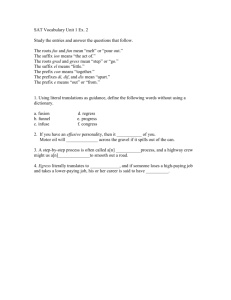7/14/2015 Advances in Focused Ultrasound Brain Therapies
advertisement
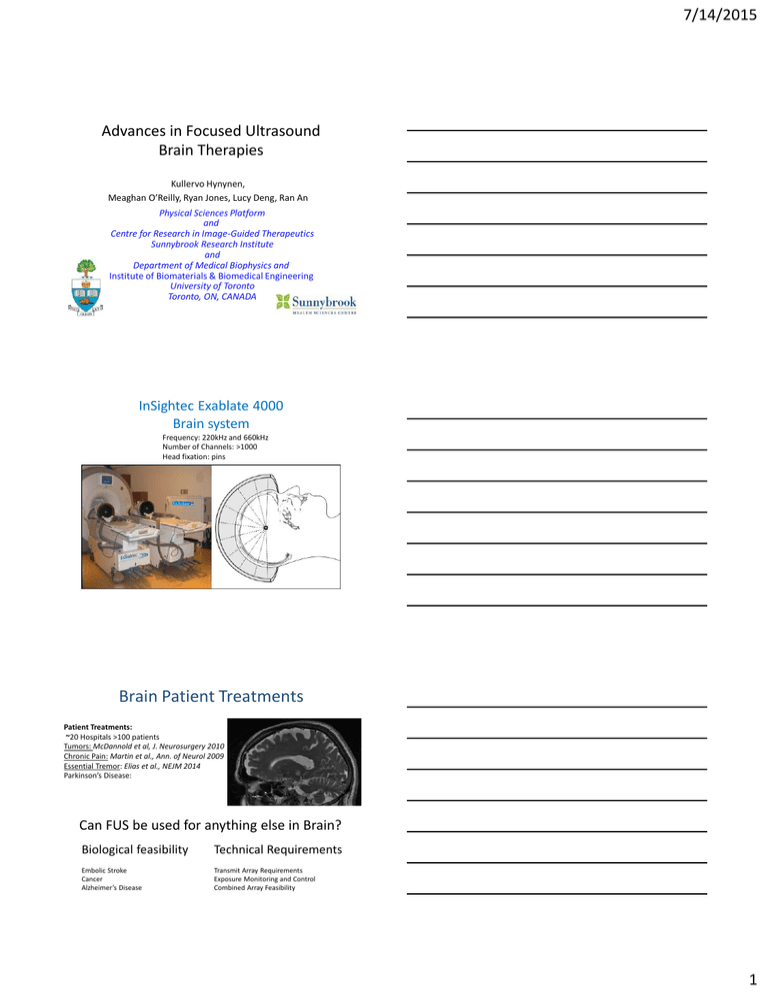
7/14/2015 Advances in Focused Ultrasound Brain Therapies Kullervo Hynynen, Meaghan O’Reilly, Ryan Jones, Lucy Deng, Ran An Physical Sciences Platform and Centre for Research in Image-Guided Therapeutics Sunnybrook Research Institute and Department of Medical Biophysics and Institute of Biomaterials & Biomedical Engineering University of Toronto Toronto, ON, CANADA InSightec Exablate 4000 Brain system Frequency: 220kHz and 660kHz Number of Channels: >1000 Head fixation: pins Brain Patient Treatments Patient Treatments: ~20 Hospitals >100 patients Tumors: McDannold et al, J. Neurosurgery 2010 Chronic Pain: Martin et al., Ann. of Neurol 2009 Essential Tremor: Elias et al., NEJM 2014 Parkinson’s Disease: Can FUS be used for anything else in Brain? Biological feasibility Technical Requirements Embolic Stroke Cancer Alzheimer’s Disease Transmit Array Requirements Exposure Monitoring and Control Combined Array Feasibility 1 7/14/2015 Stroke Treatment? FUS fragmentation of a blood clot 1.5MHz transducer, 1ms pulses, PRF =1 Hz, F-number = 0.8, 20sec duration Baseline Stroke Post-HIFU 415 W 550 W Burgess et al, Plos One 2012 Through Skull Stroke Treatments Simulations Pajek et al., PMB 2012 Through Skull Stroke Treatments Simulations Pajek et al., PMB 2012 2 7/14/2015 Problem: How can we reduce the inertial Caviation threshold? Sub-micron Droplets Sub-micron droplets are precursors to microbubbles Liquid Surfactant/Lipid Low BP liquid PFC Micron to submicron size Benefit: Can locally create microbubbles Locally induce cavitation Convert liquid droplet to gas bubble 10000 1000 Pressure (kPa) liquid 100 10 gas 1 0.1 -50 0 50 100 150 200 250 Temperature (C) 3 7/14/2015 Manufacturing Shell Material Fluorosurfactant Bovine Serum Albumin PFC Boiling Point (C) [PFC] 5% v/v [Shell material] 0.1 – 0.8 % Method Microfluidizer 10% v/v 20mg/mL Vialmix Microfluidizer DDFP PFH FC84 FC77 FC40 29 56 80 97 165 Perfluorocarbon droplet vaporization Schad et al., UMB 2010 In Vivo Brain Sonications Droplet diameter :156 - 207 nm Sonication Duration: 20s Burst Repetition Frequency: 1Hz Compares well with no droplet experiments: 550 W Burgess et al. Plos One 2012 Pajek et al, UMB 2014 4 7/14/2015 A B C S k D E F Preliminary Analysis - Vital Stain Control Sonicated Blood-Brain Barrier 5 7/14/2015 How Can Ultrasound Open the BBB? 20s Sonication Time Average Power < 10mW Hynynen et al., Radiol. 2001 10 ms / PRF = 1 Hz Time Focused ultrasound opening of BBB rabbit rat mouse Pig How can BBB opening be used for therapy? Animal Experiments (>100 studies): Effective Delivery of: -Chemotherapy* -Antibody* -siRNA -Viral vectors -Other agents -Cells* Examples: Brain Tumours* Alzheimer’s Disease* * Effective treatments in animal models 6 7/14/2015 Targeted NK-Cells HER2+ Breast Metastasis A B HER2-Specific NK-92 Cell Ultrasound Contrast Focused Ultrasound Transducer Alkins et al., Cancer Res. 73(6):1892-9, 2013 Her2-Targeted NK-92 Cells Cells Before BBBD Cells After BBBD NK cells (per 100 tumour cells) Prussian Blue 1.5 Control * * 1.0 0.5 0.0 on tr ol B B fte r A C B B B B Control B ef or e After BBBD D D Before BBBD * Indicates statistically significant result Alkins et al., Cancer Res. 73(6):1892-9, 2013 Targeted NK-Cells: In Vivo Tumours Week 1 Week 3 Week 2 Week 4 Group II Group II Survival Group II Tumour Volumes 150 Cells FUS FUS + Cells 150 Percent survival Volume (mm3) 200 100 50 0 Cells FUS FUS+Cells 100 50 0 0 10 20 Time (Days) 30 0 50 100 150 Time (Days) Alkins et al., submitted 7 7/14/2015 AD is a progressive and irreversible neurodegenerative disease that has no cure. AD is characterized by the presence of β-amyloid plaques, neurofibrillary tangles, neuronal loss, and deficits in neurotransmitters Long-term administration of high doses of antibodies against Aβ in the bloodstream remove the plaques has produced benefits in animals* but failed in patients** <= BBB prevents large molecule penetration into the brain *Bard et al. Nat Med 6: 916–919, 2000. **Grundman et al. J Nutr. Health Aging., 17, 51-53, 2013. FUS-mediated antibody delivery Jordão et al., PLoS One(2010) FUS Opening of the BBB alone Reduces pathology Jordão et al., Exp Neurol (2013) 8 7/14/2015 Is FUS effective for treatment of AD? Wildtype Transgenic Untreated Untreated FUS treated FUS treated - 7 months at start of study - Underwent treatment once per week - 8 months: behavioral analysis histology analysis Burgess et al., Radiology 2014 FUS improves performance in Y-Maze 10 min Exploration 90 min Novel Arm 5 min Burgess et al., Radiology 2014 FUS improves performance in Y-Maze 10 min Exploration 90 min Novel Arm 5 min Burgess et al., Radiology 2014 9 7/14/2015 FUS reduces plaque load Untreated FUS-treated Burgess et al., Radiology 2014 FUS increases neuronal plasticity Total Dendrite Path Length Burgess et al., Radiology 2014 Challenges of translating FUS BBB Opening to the Clinic • Monitoring and control of the bubble activity – – – – Human skull highly variable Too low exposure => no opening Too high exposure=> vascular, and neuronal damage No temperature elevation • Large volume treatments required with high precision – Close to bone and other critical structures – Large electronic steering range – Large number of focal exposures needed => fast electronic scanning required 10 7/14/2015 Full-Scale Arrays: Problem Large number of: -small elements - RF-drivers - Interconnects =>cost Sparse Array Goss et al., 1996 Sparse Arrays Pressure Across Focus Ellens et al, PMB 2011 Bubble location and activity monitoring 11 7/14/2015 Passive Acoustic Mapping (PAM) T. Sato, K. Uemura, K. Sasaki, JASA 67, 1802 (1980). S. J. Norton, I. J. Won, IEEE T Geosci Remote 38, 1337 (2000). Trans-skull Imaging of the Bubbles: • Wide aperture transcranial array – 128 passive receive elements (612 kHz) – 306 kHz prototype brain therapy array 1 • 3D bubble activity maps reconstructed – passive imaging techniques 1Song and Hynynen, IEEE TBME (2010) 2Norton and Won, IEEE TGRS (2000) Transcranial Imaging O’Reilly et al., Medical Physics 2014 12 7/14/2015 Transcranial Imaging Video: 3D projection O’Reilly and Hynynen, Medical Physics (2013) Transcranial Super-Resolution Imaging Video: 3D projection O’Reilly and Hynynen, Medical Physics (2013) Multi-Frequency Transmit-Receive Phased Array 128- elements in simulation optimized locations 13 7/14/2015 Transducer Element PAM Benchtop Set-Up Transmit Focus in Water and Through a Human Skull 14 7/14/2015 Transmit Electronic Beam Steering Through Skull Single Bubble Image at 612 kHz Conclusions Brian Treatment Phased Arrays Thermal ablations Skull heating is a limiting factor =>require fully populated arrays => Mechanically moved =>Limited phased arrays (~1000 elements) -distortion correction, limited steering Embolic Stroke Inertial cavitation High precision High pressure amplitude Large number of elements Droplets, nano-bubbles? BBB opening -Transmit/Receive Arrays -Very low time average power => skull heating not a problem =>Sparse arrays feasible => multi-frequency arrays practical Many New Treatments Possible in the Future => FUS could have a huge impact 15 7/14/2015 Acknowledgments Funding: Canada Foundation for Innovation Canadian Institutes of Health Research Focused Ultrasound Surgery Foundation Canada Research Chair Program Natural Sciences and Engineering Research Council of Canada Ontario Research Fund National Institutes of Health Industry: General Electric InSightec Collaborators: I. Aubert, PhD S. Black, MD P. Burns, PhD D.Dumond, PhD S.Graham, Ph.D. D. Goertz, PhD R. Kerbel, PhD D.Mainprize, MD J. McLaurin, PhD B. Stefanovic, PhD M.Schwartz, MD J. Rutka, MD Thank You! 16
